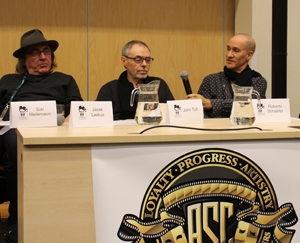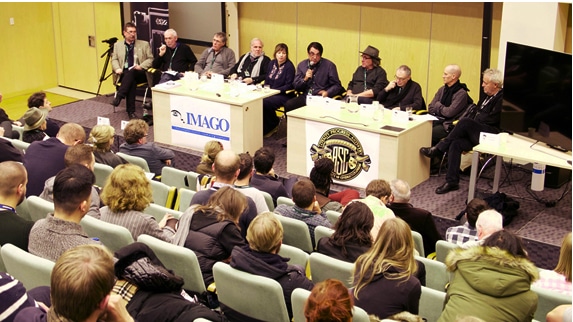
Report from Camerimage by Madelyn Most
For the first time in the history of both organizations, IMAGO and ASC, the American Society of Cinematographers, held a joint conference at Camerimage to discuss ways of promoting international cooperation and collaboration so that members of all the different national cinematographic societies can share their knowledge, technical research, experience, and expertise.
The ASC/IMAGO Conference at Camerimage. In the panel, from left to right: |
Founded almost 25 years ago, IMAGO, once a European federation, is now a global organization with 50 societies and over 4000 members from Europe, Asia, Latin and South America, Australia, and New Zealand. The ASC, founded almost one hundred years ago, is the oldest and most established cinematographic association in the world with a membership of 400. The aim of both societies is to protect artistic integrity and maintain the very highest standards of cinematography.
At a time when technology is rapidly changing in complexity and sophistication, the proliferation of new equipment, systems, and ancillary tools introduced on the market every few months has impacted on the role of the cinematographer, not always positively. It has never been more important for cinematographers around the world who face the same challenges to come together as a community and defend their profession.
The discussion was moderated by Elen Lotman ESC/IMAGO and Suki Medencevic ASC SAS, with a panel consisting of Imago members Michael Neubauer, BVK, Nigel Walters BSC (Vice President of the BSC), Phillipe Ros, AFC, and Louis-Philippe Capelle, SBC, General secretary of IMAGO.
Members from the ASC included Suki Mendencevic ASC, (also head of the ASC International Committee), Roberto Schaefer, ASC AIC, John Toll ASC, Jacek Laskus ASC PSC, and Checco Varese ASC AMC. Present in the audience was Paul Rene Roestad FNF, President of Imago.
Elen Lotman began by saying “A few years ago in Los Angeles some said that cinematographers are an endangered species, we would disappear like the dinosaurs, (which I never believed, coming from Europe) but if we stay informed of the changes, we are more likely to survive. If we stay united and strong and learn from each other, we can keep up with the changes in the industry.”
Keeping control over our images
The panelists discussed a wide variety of topics affecting their work, but the greatest shared concern was the cinematographer’s loss of control over their images in this rapidly changing digital World. In some countries cinematographers are protected by cultural or educational ministries and laws, but in others, “it’s a jungle out there.” Since the introduction of the DI, it has become more difficult for the cinematographer to trust that the production will allow them to do the final work, ensuring that cinematographer´s original artistic intentions for the film won’t be altered in post-production. The cinematographer is the person necessary to follow through on the original concept but often it is the producer or the director who decides if the cinematographer can finish the film and if they will get paid or not for using their time in post. They must trust you and rely on you. Even though the director is (or should be) the cinematographer’s best ally there are no guarantees and most situations must be negotiated. “The technology can work against us, anybody can in theory do the post, but only the cinematographer can ensure the visual and artistic quality of their work.”
One panelist said “No one is going to misuse your images if you photograph something in a certain way so that it cannot be manipulated. With these new digital tools it is much easier for them to destroy images once they get their hands on them.”
“In the very beginning of the project, let it be known that your intention is to be with the project until the end, from pre-production to post. Your agent should put the language in your contract as part of your agreement.”
A member from Belgium spoke about HDR. “HDR is going to be very important and there will be more possibilities for grading, highlights, detail in the dark, shadows, contrast, etc. We will be seeing things that were not intended to be seen. Controlling dynamic range and contrast in cinema or Tv broadcast must be addressed by our technical committees.”
Philippe Ros AFC, IMAGO Technical Committee, added that manufacturers should give cinematographers access to the controls inside the camera so they can control texture and sharpness and overall look of the image. The more the technical committees work with manufacturers, the more information we will get.
Working Conditions
A serious concern is the increasing number of working hours in the day that can be up to 14-16 hrs. on many productions. Each Country has its own (union) guidelines and labour laws, but some unified standards could be established to protect against excessive hours.
Over the years, Imago has been effective in promoting international cooperation in countries that have limited laws to regulate working conditions. Although Imago is not a Union, we work to promote acceptable working conditions towards all member´s Societies. Imago believes fostering greater ties between World Societies of Cinematographers and exchanging experiences and knowledge will make it easier to reach our goals.
Author’s Rights and respect
Nigel Walters BSC: Cinematographers are the creators or author of images and therefore should maintain the right of co-authorship of the film. Certain countries have already adopted this legislation while others have challenged it. Imago has been successful to protecting and defending these laws.
Trying to get the conversation back on track, Nigel Walters BSC continued “We are supposed to be talking about international collaboration, but It’s all about RESPECT. Cinematographers need to be respected and their work needs to be respected. We are in some Countries “Below the line” and as such, are put in the category of technicians. We have to get back to being considered a ‘creative’ entity where we are “Above the line”. If we are a united group of 50 societies working together in solidarity, this could strengthen our position.
In Conclusion:
Both IMAGO and ASC have a number of important yearly activities: Master classes, seminars and conferences, in addition to the Committees making tests and technical reports. The national Cinematographers Societies also have activities regarding the artistic and technical developments.
Cinematographic societies hold regular meetings, conferences, and events that allow participating members to share their experiences, exchange ideas, and strengthen relationships.
The ASC and IMAGO have a network of thriving committees in place: Education and Outreach, Mentoring, Technical, Authorship, Diversity, etc.. Workshops and Masterclasses are important to transfer new skills to members, students, and aspiring cinematographers. Other national societies have filmed their masterclasses and are considering putting them on social media websites such as Facebook or YouTube so that everyone can share this information.
IMAGO will continue to work with the ASC and our more than 50 Cinematographer´s Societies to see that these experiences and knowledge can be shared by cinematographers world-wide.
The digital revolution has altered the cinematography profession and Imago, the ASC, and their affiliated societies are working to create the conditions for a positive future by developing an ongoing strategy for collaboration and cooperation.
This important Conference laid good grounds for experience and knowledge being more regularly shared also between the ASC and IMAGO, and through IMAGO, also transferred to our international network of members.
IMAGO is grateful for the initiative and great help from Kees van Oostrum ASC President, and Suki Medencevic ASC SAS, in arranging this important conference. IMAGO and ASC are both grateful for the extensive help received from Camerimage, particularly from Kazik Suwala and his fabulous team.



























